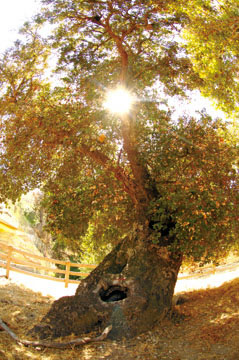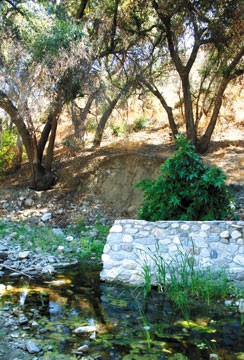BUSINESS
Inside SCV History
The California Golden Dream
October, 2005 - Issue #12
 |
Here in Placerita Canyon, one oak tree stands out among the others. Surrounded by a wooden fence and two placards detailing its significance, not just in local history but in the entire shaping of the Western United States, stands the Oak of the Golden Dream.
It was here, 163 years ago, that Francisco Lopez was napping among this same grove of trees. In his slumber, he dreamt he was surrounded by a city of gold and riches. After he awoke, he plucked a few wild onions from the ground. Attached among the roots were small pieces of gold. This was the first recorded gold discovery in California, six years before the finds at Sutter's Mill by James Marshall and others that started the infamous California Gold Rush.
The area around the oak grove, including the adjacent Placerita Creek, was mined for the next few years using panning and sluice methods. While the finds were not substantial in volume, their certainly were of great historic value. But while this was the first recorded discovery, it was certainly not the first find. Residents of the local mission outpost (a sub-station for Mission San Fernando located near present-day Hasley Canyon) are believed to have known about the richness of the land for years. Outpost members as well as Native American inhabitants had known of local gold in that region of the valley for, according to some historical accounts, two or three decades before the discovery at Placerita Canyon. While there is only legend and lore about these finds, there is certainly plausible evidence as to their factuality.
 |
Since its birth, the Oak of the Golden Dream has lasted through much more dangerous situations than those brought on by over-zealous miners. The most recent fires blackened hills a stone's throw away. (Fire and oak trees do maintain a peaceful coexistence. Without fire, the acorns, which are the oak tree's seeds, would never mature enough to spawn new growth. Fire is actually part of a rebirthing process for the oaks.)
Oak of the Golden Dream is part of the Placerita Canyon Nature Center managed by the Los Angeles County Parks and Recreation Department. The park is open from sunrise to sunset every day with numerous opportunities for hiking and picnicking. The Nature Center on site displays many native animals and plants and can be visited from 9 a.m. to 5 p.m. daily. More information can be found at www.Placerita.org or by visiting the park located just a few miles south-east of State Route 14 along Placerita Canyon Road.
|
||||||||||||||||||||||||||||





